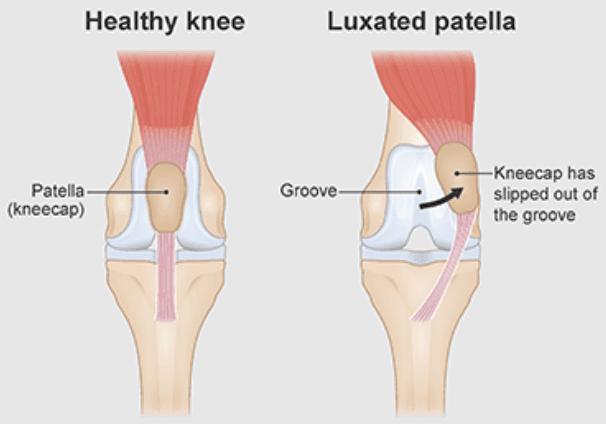Puppy Care Guide
Week 36 – Preventing Patellar Luxation in Puppies

As your puppy nears nine months, their joints are rapidly developing. This week’s guide explains what patellar luxation is, how to spot early warning signs, and what you can do to keep those little knees strong and healthy.
🦴 Understanding Patellar Luxation
Patellar luxation occurs when the kneecap slips out of its normal groove in the thigh bone. It’s common in small breeds like Pomeranians, Maltese, and Toy Poodles, though any dog can be affected. Genetics play a major role, and early signs may appear even in young puppies.

🐾 Recognizing the Symptoms
- Skipping or limping on one hind leg.
- Difficulty climbing stairs or jumping.
- Clicking sound or leg shaking during movement.
- Reluctance to run, play, or bear weight.
- Knee appearing off-center or sliding inward.
Vets grade luxation from 1 to 4 — mild cases slip occasionally, severe ones stay dislocated and can deform joints over time.
Why Early Detection Matters
Untreated luxation weakens ligaments and cartilage, leading to arthritis or chronic pain. Catching it early allows for non-surgical care like muscle strengthening, supplements, and weight control.
💡 PetGo Tip: Schedule annual orthopedic checks for small breeds — early intervention prevents long-term damage.
✅ PetGo Self-Check for Patellar Health
- Limping or hesitation on stairs.
- One leg lifted or “skipping” gait.
- Clicking or popping in knees.
- Difficulty standing after rest.
- Reduced interest in active play.
🩺 If any of these appear, book a veterinary exam promptly — waiting may increase the need for surgery later.
Prevention Tips for Canadian Pet Parents
- Create Non-Slip Spaces: Use rugs or mats to protect growing joints.
- Limit Jumping: Avoid bed or couch leaps; add ramps or steps.
- Maintain Healthy Weight: You should feel ribs easily without pressing hard.
- Discourage Standing on Two Legs: Encourage calm four-paw posture.
- Low-Impact Exercise: Gentle walks or swimming strengthen knees safely.
- Joint-Supporting Nutrition: Diets with omega-3, glucosamine, and chondroitin keep cartilage strong.
🏥 Veterinary Care & Treatment Options
Mild (Grade 1–2) cases often improve with exercise control, supplements, and weight management. Severe (Grade 3–4) cases may need surgery to realign or deepen the patellar groove, followed by physiotherapy.
💡 PetGo Tip: Post-surgery recovery depends on consistent rehab and lifestyle care — prevention doesn’t stop at the clinic.
💛 PetGo Reminder
Strong, pain-free joints are the key to your puppy’s confidence and joy. If gait or posture changes, act early — prevention today means freedom of movement tomorrow.
Early action, lifelong comfort.
Continue with PetGo’s Puppy Care Guide
Track your puppy’s joint health, weight, and vet visits easily in the PetGo App — your partner in lifelong wellness.
© 2025 PetGo. All Rights Reserved
